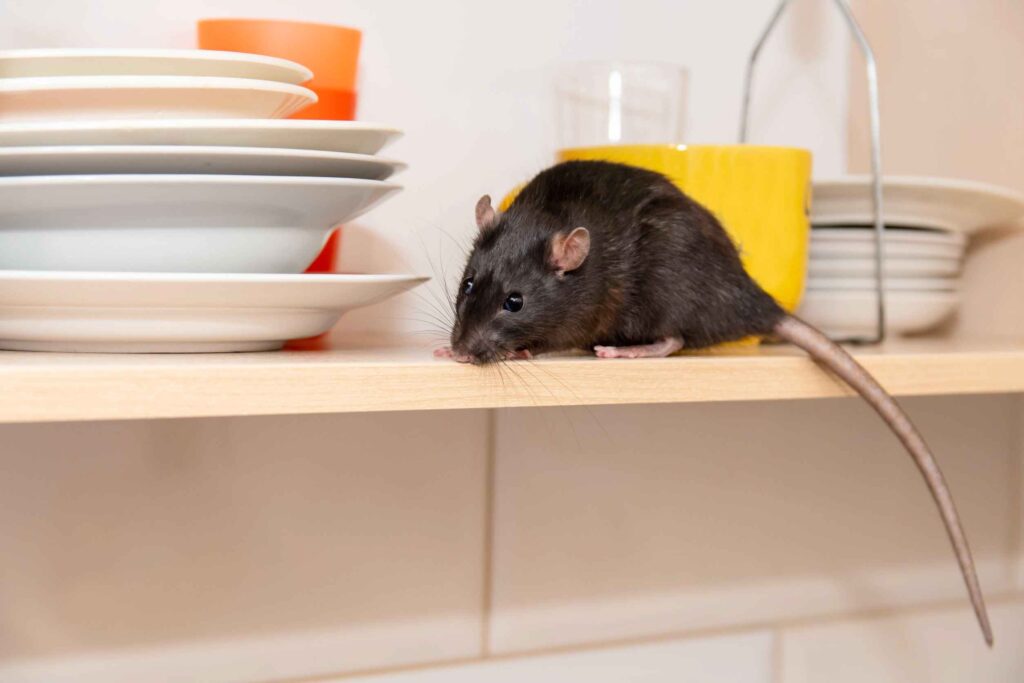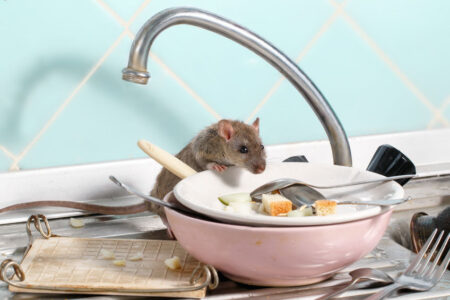
Sometimes it can be the smallest critters which create the biggest problems for landlords. Pest infestations are unpleasant for tenants to live with and can be costly to rectify. Naturally, this begs the question of who is ultimately responsible for managing and rectifying pest problems in tenanted properties. Does the responsibility lie solely with the landlord, or is the matter less binary?
To shed light on everything landlords need to know about the pest control industry, Kelly Farrant – Director of Maidstone-based Pest-Tech Limited – has put together a guide to the most common types of pests, how they occur and who is ultimately responsible for rectifying the issue:
Pest Control, Is It a Landlord’s Responsibility?
Pest problems occur in rented properties, no matter what type of property. A question we often get asked by landlords and property management companies that have pest issues is “are we responsible?” There is no right or wrong answer to this as everyone has a responsibility to play. This blog looks to cover this in more detail to ensure you as a landlord can protect yourself, your building and the tenants that rent it.
Pest Control and the Tenancy Agreement
The tenancy agreement and the rules laid down within this document are the first things to consider. It is commonly the case that accountability for pest outbreaks is omitted from the document. It is not expected that all pest infestations are either the landlord’s fault or the tenants. Therefore, an important step to take when drafting new tenancy agreements is to ensure that there is clear guidance over who is responsible for what will, leaving the tenant and landlord knowing exactly where their responsibility lies. This will make sure there is no confusion or disputes and maintain a good relationship between both parties.
Integrated Pest Management
Integrated Pest Management is a term used to incorporate all available pest control techniques, procedures and measures that will prevent the development of a pest infestation. Experience in dealing with the plethora of possible pest problems that occur in tenanted properties suggests that there are generally underlying issues that initiate a pest infestation. In fact, there are a number of fundamental causes that make the chance of getting a pest problem more probable, such as:
Poor Maintenance of The Property
If a property has been in the rental market for a long time, there may be a certain amount of neglect that occurs over time through poor reporting of maintenance or through tenants trying to self-help thinking they are assisting, but the repair is poor or substandard. It is also common for a subsection of tenants to mistreat the property as it is not their own home. Equally, properties are an investment for a landlord, so it is natural to want to minimise maintenance costs to retain profitability. However, if this goes too far it can impact the condition of the property and eventually lead to more significant costs later down the line. Simply, if a property is poorly maintained, then expect to get pest issues.
Property Not Being Looked After by The Tenant
Some tenants do not care for their rental property in the same way a homeowner would. If a tenant does not clean the house, it is their choice. However, a dirty home encourages all manner of pest infestations. When a kitchen does not get cleaned, a build-up of food waste, oil and grease and crumbs builds up on surfaces, on the floor and between kitchen units. This is the perfect environment for public health insects such as German Cockroaches. It is important that the property is cleaned to reduce the chance of an outbreak of a pest infestation.
Maintenance of outside spaces is also a common problem, especially if the tenant doesn’t use the garden. Not all tenants have green fingers and enjoy gardening. In these situations, the outside space may become a bit of a dumping ground which creates a great environment for rodents. An overgrown garden creates the perfect environment for not only rodents but vermin such as foxes. Most standard Assured Shorthold Tenancy Agreements (ASTs) include clauses stating the tenant’s responsibility to keep on top of weeds and mow the lawns. However, in practice, this can be hard to enforce.
For more about garden maintenance responsibilities, Landlord Vision has put together a post on whether garden maintenance is a landlord’s or tenant’s responsibility:
The Location of the Property
The location of a property may be completely out of your control. If a property backs onto a wooded or grassed area, then it’s hard to control the environment. In situations like this, all you can do is ensure the building is protected and proofed. This also applies when a house is attached to a food convenience store or a takeaway. Bin areas and smells will naturally attract unwanted pests to the area. A next-door neighbour’s house or garden may be the cause of a pest issue for all the same reasons mentioned above. There are always holes in voids under the building or in the loft and rodents will migrate from one house to another in search of food.
Type of Rental Property
Terraced houses are prone to getting mouse issues because mice can travel easily from house to house. They migrate through a row of terrace houses in search of food going from house to house. A mouse infestation in a terrace house is a pest controller’s nightmare. It is not uncommon for pest control technicians to have to treat multiple houses on the back of a single mouse infestation.
A House of Multiple Occupancy (HMO) brings its own issues as they have often been bashed about a bit which makes it easy for rodents to find routes around the building. Having numerous people in a house means different living styles all under one roof. The transfer of bed bugs is another common problem in an HMO and poor reporting for fear of getting the blame often means the problem is far worse before it is found.

What can be done using Integrated Pest Management in a Rental Property?
By implementing techniques which are mostly common sense you can reduce the chances of getting a pest-related problem on a property. The list is a guide to implementing Integrated Pest Management, but the list is not exhaustive:
- Regular cleaning and good housekeeping.
- Carry out regular inspections of the property and maintenance where required.
- Check the property in the autumn for rodent entry points, both inside and out. Insure blocking of holes and proofing.
- Use professional and skilled labour to carry out work on the property.
- Good maintenance of the garden.
- Manage rubbish within the property and bin area in blocks and HMOs.
- A robust reporting system for faults and repairs for the tenant.
- Quick follow-up action for any faults and repairs. This may reduce the cost of dealing with a pest treatment by not leaving it.
- In general, keep areas clean and tidy and keep an eye on what is happening at neighbouring properties.
Hopefully, by following the above, you will be able to limit the chance of falling victim to a pest problem in your properties.
What are the Common Pests found in a Rental Property?
The list is endless when it comes to pests found in rental properties, however from a pest control expert, there are a few obvious pests to consider when writing your agreement.
Rats and Mice. Without a doubt the most common problem in a rental property for all the reasons mentioned above. No matter how the tenant lives it is normally the building that has failed in some way that has allowed the rodent to gain entry so is not the tenant’s fault.
Wasps and Bees. Like rodents, this is not a pest that can be blamed on the tenant. They are completely indiscriminate about where they build their nests and there is not a lot that can be done to stop this happening but deal with the problem when it occurs.
Bed Bugs. Bed bugs are normally introduced to the property which means the tenant will have brought them in. It is unfair for the landlord to have to pay for treatment, because of the tenant’s actions. The only exception to this is when the previous tenant left an infestation, and a new tenant moves in and has the problem. It will be identified almost immediately so it will be easy to identify responsibility. This can be worse for a landlord in a furnished flat if the infestation has spread throughout because of poor reporting.
Fleas. Fleas are another pest issue that’s introduced to a property. You may have a no-pet policy so a flea infestation may suggest a pet has been kept on the property without your consent. If you allow pets in your rental property, you should consider enforcing a pest control clearance certificate at the end of the tenancy. Failure to do this may cause the next tenant to pick up the flea issue as they can lay dormant if untreated.
Silverfish. Silverfish are scavengers and live off mould spools caused by high humidity, poor ventilation or a water leak. The problem is normally found in kitchens, bathrooms and airing cupboards. If it is because of a leak, then it most likely will be a landlord issue. This infestation is common in HMOs when there are shared bathrooms with lots of occupants using showers with high humidity, often keeping the windows shut if any and a small extractor fan. Also drying washing in a confined space can cause too much humidity.
Nesting Birds and Squirrels. Both these issues occur in a loft which normally indicates a proofing issue at the roof level and a landlord’s responsibility. It is important to remember most common birds are protected when nesting so can’t be touched. Squirrels are prolific gnawers and can do some serious damage to cables causing a rewire.
Summary
Hopefully, the information will help you to deal with your rental property concerning pests and why they may occur. Whilst we may only be scratching the surface with this post, knowledge of Integrated Pest Management should help you to be proactive and maintain a pest-free environment, for you and your tenant. By applying the recommendations, you will be able to save money and have a well-maintained property.
To learn more about pest control in your properties, visit www.pest-tech.org and check out our blogs.
About Pest-Tech Limited
Pest-Tech Ltd is a Maidstone-based Pest Control Company, that delivers pest control services to the domestic and commercial markets across Kent. We offer a wide range of services including reactive call-out facilities for immediate treatments and emergencies, but also Annual Service Contracts to support companies that need peace of mind that their business is protected. We are members of the British Pest Control Association and this demonstrates our professionalism by offering the gold standard when delivering our services.
To date, we service contracts for businesses and homes which vary from Schools and Care Homes to Food Outlets and all manner of Industrial Units. All our Pest Control Services conform to industry standards and legislation when dealing with the treatment of all pests. Food production brings its challenges, and we can work to BRC standards with the support of a field biologist on call.
As well as dealing with all the usual pests such as rats and mice in the winter and ants, wasps and bee nests during the summer, we also deal with all-year problems such as fleas, bed bugs, cockroaches, carpet beetles, moths and many more. We conduct wildlife management which includes the control of squirrels, foxes, moles and rabbits.



